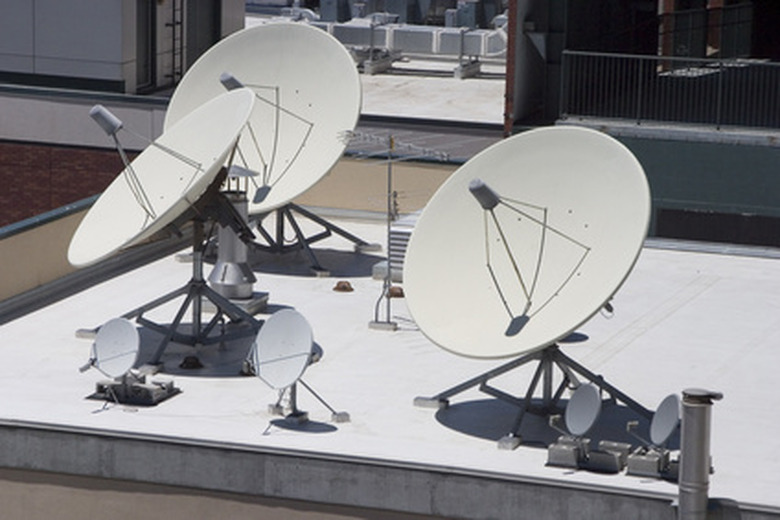How To Make A Simple Radio Telescope
Radio astronomy is the science of using radio waves to explore the universe. Radio receivers are used to listen to the sun, the moon, the Earth itself, Jupiter, the Milky Way and even objects in other galaxies. All of these bodies emit radio frequency (RF) energy, which you can listen to with various types of radio receivers and antenna systems. When you hear the hiss of white noise on vacant frequencies (channels) between radio and television stations, you are listening to the electromagnetic energy of the sun, Jupiter or both. You can make the simplest radio telescope using an ordinary satellite dish antenna and a signal strength meter to monitor the sun.
Step 1
Gather your materials and mount the satellite dish antenna to a rotatable Lazy Susan. Either new or used parts will work just fine depending on your budget.
Step 2
Use the standard dish-mounting hardware and the Lazy Susan to ensure you can adjust or rotate your antenna both horizontally and vertically so that you can aim it anywhere easily.
Step 3
Connect one end of a 6-foot CATV cable to one of the LNB (low noise block) connectors on the dish and connect the other end to the LNB connector on the satellite signal strength meter.
Step 4
Attach terminating resistors to any unused CATV connectors on the LNB to prevent signal loss. Some DirecTV dish LNBs have four terminals, so you will attach your coax to one connector and the terminal resistors to the other three.
Step 5
Solder the small RF choke in series (in line) with the center conductor (positive) of the other 6-foot CATV coax section and attach a male coax connector to the other end of the coax. This coax will connect the 12- to 16-volt power supply to the signal meter.
Step 6
Connect the RF choke end of the power supply cable to the 12- to 16-volt power supply or battery pack. The battery pack configuration allows for remote operation of your radio telescope away from potential electrical noise. Be sure to connect the center coax conductor (with RF choke) to the positive (+) terminal of the power supply or battery pack.
Step 7
Connect the male connector end of the power supply cable to the "SAT Rx" connector terminal on the satellite signal strength meter. This is where the meter normally draws power from the CATV control box. Your radio telescope is now complete.
Things Needed
- 18-inch satellite TV dish antenna (and standard dish mounting hardware)
- Lazy Susan rotatable base
- Satellite signal strength meter (Channel Master or Signalmeter)
- 2 pieces CATV coaxial cable, 6 feet long
- 3 CATV "male" coax connectors
- 3 CATV terminating resistors
- Power supply (12 to 16 volts) or a 12-16 volt battery pack
- Small RF choke (any value)
- Soldering iron
- Radio Shack Computer Interfaced Digital Volt Meter and cable
- The Radio Sky CDROM-I Software Collection
- Computer with Internet access
TL;DR (Too Long; Didn't Read)
Test your new radio telescope by pointing the dish directly at the sun on a clear day. The hours between 10 a.m. and 2 p.m. local time are best. Observe the signal meter and adjust the gain control for maximum signal strength. You are now listening to the sun.
Check SpaceWeather.com daily for updates on solar activity, sunspots, solar flares and solar storms. You should be able to detect these events by observing signal strengths higher than normal with your radio telescope.
Join NASA's Radio JOVE Project. Radio JOVE students and amateur scientists from around the world observe and analyze natural radio emissions of Jupiter, the sun, and our galaxy using very easy-to-build (14 MHz) receiver kits and existing short wave radios.
Get your Amateur Radio Operator's (Ham Radio) License so you can also transmit radio signals and bounce them off satellites, the International Space Station (ISS), meteors in space and the Moon. http://www.arrl.org/
Warning
Antennas conduct electricity and attract lightning.
Keep antennas away from power lines.
Before lightning strikes, and whenever any antenna is not in use, disconnect and safely ground all antennas.
Cite This Article
MLA
Wamback, Steven J.. "How To Make A Simple Radio Telescope" sciencing.com, https://www.sciencing.com/make-simple-radio-telescope-6630765/. 24 April 2017.
APA
Wamback, Steven J.. (2017, April 24). How To Make A Simple Radio Telescope. sciencing.com. Retrieved from https://www.sciencing.com/make-simple-radio-telescope-6630765/
Chicago
Wamback, Steven J.. How To Make A Simple Radio Telescope last modified August 30, 2022. https://www.sciencing.com/make-simple-radio-telescope-6630765/
